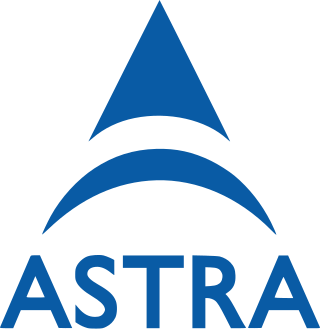
Digital Video Broadcasting (DVB) is a set of international open standards for digital television. DVB standards are maintained by the DVB Project, an international industry consortium, and are published by a Joint Technical Committee (JTC) of the European Telecommunications Standards Institute (ETSI), European Committee for Electrotechnical Standardization (CENELEC) and European Broadcasting Union (EBU).

ProSieben is a German free-to-air television network owned by ProSiebenSat.1 Media.
TVNorge is a Norwegian television channel owned by Warner Bros. Discovery EMEA.
Canal Digital was a Nordic pay TV and internet service provider in Norway, Sweden, Denmark and Finland that was founded in March 1997 as a joint venture between the French pay TV company Canal+ and the Norwegian telecommunications operator Telenor.

3sat is a free-to-air German-language public service television channel. It is a generalist channel with a cultural focus and is jointly operated by public broadcasters from Germany, Austria (ORF) and Switzerland. The coordinating broadcaster is ZDF, at whose Mainz facility the broadcasting centre with studios for in-house productions is located.
Television in Germany began in Berlin on 22 March 1935, broadcasting for 90 minutes three times a week. It was home to the first public television station in the world, named Fernsehsender Paul Nipkow.
CCTV-1 is the primary channel of CCTV, the national flagship terrestrial television network of the People's Republic of China. It broadcasts a range of programs from CCTV Headquarters at East 3rd Ring Road in Beijing and is available to both cable and terrestrial television viewers. The terrestrial signal of CCTV-1 is free-to-air across China. However, due to copyright restrictions, the satellite signal of CCTV-1 is encrypted, and smartcards are necessary for decryption.
The television industry in Turkey includes high-tech program production, transmission and coverage. Turkish Radio and Television Corporation is Turkey's largest and most powerful national television station. As of 1 August 2019, RTÜK states that there a total of 536 television channels in Turkey. Turkey is the world's fastest growing television series exporter and has currently overtaken both Mexico and Brazil as the world's second highest television series exporter after the United States. Turkish television drama has grown in since the early 2000s.

Tele 5 is a German free-to-air television channel that broadcasts classic American films, series, cartoons and Japanese anime.
ORF 2 is an Austrian public television channel owned by ORF. It was launched on 11 September 1961 as a technical test programme. Today it is one of the four public TV channels in Austria.
Television in Switzerland was introduced in 1950, with regular broadcasts commencing in 1953. People who live in Switzerland are required by law to pay a television licence fee, which is used to finance the public radio and television service SRG SSR. Since 1 January 2021, the Licence fee cost in all the linguistic regions of Switzerland is 355 CHF per year or 83.75 CHF quarterly, counting both radio and television licences. All licence fee payers are entitled under the law to services of equal quality. The fee is charged per household and not per person, with empty dwellings being exempt. The fee is determined by the Federal Council.
Television in Poland was introduced in 1937. It was state owned, and was interrupted by the Second World War in 1939. Television returned to Poland in 1952 and for several decades was controlled by the communist government. Colour television was introduced in Poland in 1971. Private television stations in Poland appeared around the time of the fall of communism, with PTV Echo becoming the first private station in Poland.

Astra 19.2°E is the name for the group of Astra communications satellites co-located at the 19.2°East orbital position in the Clarke Belt that are owned and operated by SES based in Betzdorf, Luxembourg.

Television in Austria was introduced in 1955. The country uses DVB-T for broadcasting. Analog television was completely shut down on 7 June 2011. Austrian television was monopolised by government-owned television stations until 1996. The first private television station in Austria was ATV.
Puls 4 is a terrestrial television channel in Austria. As its name implies, it is the fourth Austrian-wide full-service television channel, behind ORF eins, ORF 2, and ATV.

HD+ is a premium high-definition (HD) satellite television service for German users, owned by HD PLUS GmbH, a subsidiary of SES based in Unterföhring near Munich, Germany.

ORF III, sometimes called ORF 3 is an Austrian television channel owned by the Austrian national broadcaster, Österreichischer Rundfunk (ORF). The channel launched on 26 October 2011 at 14:00 CEST, and replaced TW1.
kabel eins classics is a German pay-tv channel owned by ProSiebenSat.1 Media. A sister channel of kabel eins it first went on air on 1 June 2006. It broadcasts 24 hours a day, mainly films and series from the 1940s to the late 1990s. On Saturdays, films from the 2000s are shown.
Sat.1 emotions is a ProSiebenSat.1 Media pay-TV channel. It started broadcasting on May 3, 2012 at 8:15 pm. It replaced Sat.1 Comedy. ProSiebenSat.1 Media also operates the two pay-TV channels kabel eins classics and ProSieben Fun.









